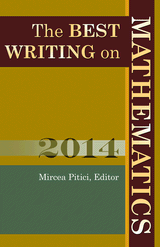The Best Writing on Mathematics 2014by Mircea Pitici (ed) |

|
The fifth book in "The Best Writing on Mathematics" series adheres the standard of excellence set up by its predecessors. Fortunately for the readers, it also reverses the trend of diminishing size exhibited by the series so far. This is also the first book in the collection to feature color inserts.
The collection consists of 24 articles of which all are recent, except one, but which still has significant relevance to today's educational logistics. D. Gale and L. S. Shapley's "College Admissions and the Stability of Marriage" (1962) offers an optimal strategy and algorithm that would satisfy both colleges and students: colleges in their search of worthy candidates, students in their attempt to be admitted to a college of their choice. The problem is solved by abstracting to a less than practical problem of insuring a stable set of marriages between equal number of men and women. The authors conclude their article with the following observation:
... it may be convenient to have an illustration at hand to show that mathematics need not be concerned with figures, either numerical or geometrical. For this purpose, we recommend the statement and proof of our Theorem 1. The argument is carried out not in mathematical symbols but in ordinary English; there are no obscure or technical terms.
The chapter "Chaos at Fifty" by A. E. Motter and D. K. Campbell deals with even more important discovery overlooked by the scientific community for a long period of time:
One might have expected that Lorenz's seminal publication - a model of clarity and concision - to have attracted immediate attention. It did not. Twelve years after its publication, the paper has accumulated few than 20 citations.
I find the collection admirable. There is of course no arguing about the tastes. However, had I suggested that every reader would be able to find at least a couple of articles in the book to his or her liking or to match one's interests, I would have done the book a great disservice. I think the pattern of thought and valuation that has been discussed in J. H. Conway and J. Shipman's "Extreme Proofs I: The Irrationality of $\sqrt{2}$" may apply to characterize the collection at hand. Conway and Shipman argue that common declarations of a math statement as beautiful, or proofs as "the best", are inherently questionable because different people have different value functions (brevity, generality, constructiveness, visuality, nonvisuality, "surprise," elementarity) they apply to judging a mathematical entity. Conway and Shipman propose to consider mathematical objects as regard their optimality to one or more value functions. Proofs, e.g., are thought to be illustrated by a convex polygon, with proofs optimal according to one or more criteria as vertices. These are "extreme" in the sense of, say, linear programming.
I would characterize the articles in the book as extreme in terms of several value functions: clarity, lucidity, instructiveness, wittiness, modern day pertinency, broad accessability. The editor's one paragraph descriptions of each of the chapters could be found on internet (e.g., log into the amazon.com, in Windows, right click on the cover, choose "First Pages", and then browse back till you see "Contents of the Volume" in the Introduction.)
My personal favorite is the second chapter, "The Rise of Big Data" by K. Cukier and V. Mayer-Schönberger. The amounts of data that are or could be collected and efficiently processed effectively illustrate the dialectic transition of quantity into quality. Applications range from drastic improvement in machine translation to the ability to recognize an unauthorized driver just by observing the weight distribution over a car seat. This article has captured my imagination, but I enjoyed practically all others. Tanya Khovanova perfectly demonstrates her mathematical prowess by solving J. Conway's puzzle which was followed up with a model problem solving approach of thinking up a simpler puzzle, and then also a more general one. Conway himself argues about unsettleable (a softer substitute for "unsolvable") problems. B. Hayes talks of the plane filling curves and their application to a practical solution of the TSP - the traveling salesman problem. F. S. Su's "The Lesson of Grace in Teaching" is an uplifiting reading for every one in the teaching profession. There are several other chapters of special interest to teachers, for example, the one about generic proofs, proofs of special cases that nonetheless included all the elements of the general statement.
On the whole, the book is informative and thoroughly entertaining. The editor, Mircea Pitici, should be congratulated for the job done well and with the taste to my liking.
The Best Writing on Mathematics 2014, by Mircea Pitici (ed). Princeton University Press, 2014. Softcover, 360 pp, $24.95. ISBN 0691164177.
|Up| |Contact| |Front page| |Contents|
Copyright © 1996-2018 Alexander Bogomolny73600003
